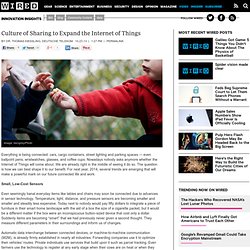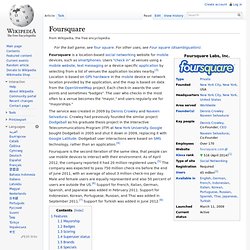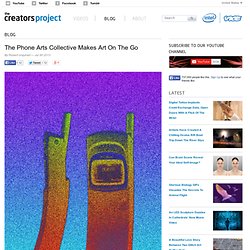

Culture of Sharing to Expand the Internet of Things. Image: bengrey/Flickr Everything is being connected: cars, cargo containers, street lighting and parking spaces — even ballpoint pens, wristwatches, glasses, and coffee cups.

Nowadays nobody asks anymore whether the Internet of Things will come about. Mobile unit based on Gregory Boulevard 17/18 January. Let Me Explain Why Miley Cyrus’ VMA Performance Was Our Top Story This Morning. Over the years, CNN.com has become a news website that many people turn to for top-notch reporting.

Every day it is visited by millions of people, all of whom rely on “The Worldwide Leader in News”—that’s our slogan—for the most crucial, up-to-date information on current events. So, you may ask, why was this morning’s top story, a spot usually given to the most important foreign or domestic news of the day, headlined “Miley Cyrus Did What???” And accompanied by the subhead “Twerks, stuns at VMAs”? It’s a good question. And the answer is pretty simple. Foursquare. Foursquare is a location-based social networking website for mobile devices, such as smartphones.

Users "check in" at venues using a mobile website, text messaging or a device-specific application by selecting from a list of venues the application locates nearby.[3] Location is based on GPS hardware in the mobile device or network location provided by the application, and the map is based on data from the OpenStreetMap project. Each check-in awards the user points and sometimes "badges". The user who checks in the most often to a venue becomes the "mayor," and users regularly vie for "mayorships. " Foursquare is the second iteration of the same idea, that people can use mobile devices to interact with their environment. As of April 2012, the company reported it had 20 million registered users.[5] The company was expected to pass 750 million check-ins before the end of June 2011, with an average of about 3 million check-ins per day.
Features[edit] Mayorship[edit] Badges[edit] Scoring[edit] Digital billboards ... big, bright, bold - and banned. Flashing and moving "digital billboards" in Brisbane - virtually large-scale television sets - will be banned on Tuesday by the Brisbane City Council.

The council says large moving images on roadsides are a potential distraction to motorists and can cause traffic accidents by drawing drivers' eyes from the road. The ban will not apply to warning signs at roadworks. Neighbourhood Planning committee chair Cr Amanda Cooper said the problems were obvious and planning laws need to change. Advertisement “This poses potential issues on our roads as traditional billboards are replaced by high-tech digital signs that are basically de facto television sets," Cr Cooper said. The Phone Arts Collective Makes Art On The Go. Image by Barnie Page.

PhoneArts.Net is an online collaborator network of likeminded creators who use mobile apps to update the way we see sketchbook culture. Two years in and nearly 300,000 Tumblr followers later, Phone Arts are staking their internet claim as an international visual punk supergroup that hangs out on their cell phones—no matter what their detractors may say. Born out of a desire to kill some time, founders Guillaume Hugon and Daniel Littlewood were swiftly joined by contributors Barnie Page, Michael Manning, Brian Metcalf, Bonjour Jean-Jacques, Antoine Aillot, Marcel Kaczmarek, Jeremiah Johnson and Mo Marie—all well-regarded internet artists in their own right.
Collectively, the group contributes their own creations and also act as curators for the many submissions the site receives from other would-be iPhone Picassos and Basquiats. Image by Thomas Pregiato. dare.uva.nl/document/170402. Monumental attractions erkki huhtamo. intra.iam.hva.nl/content/1011/cim/understanding_public_spaces/intro-en-materiaal/iinteractivecity_struppek_urbanscreens.pdf. Leiden Anthropology Blog - Articles - Exposing the interface: the critical future of (cyborg) anthropology. By Ebayink Should ditigal research by anthropologists, or cyborg anthropology, be made available as a corporate market research technique?

Or should it make explicit how our “predictions” for the future normalize political and corporate interests? “Wear these glasses. This is the Future” On February 21, 2013, the front pageof the Dutch newspaper NRC-Next carried a picture of a woman wearing an odd-looking pair of glasses. Whitespace: Wearable computers - the fifth screen has arrived. Issue 84: April 2012 Screens have dominated our lives for nearly 60 years.

First there was the TV, then came the second screen in our lives, the PC. Ubiquitous internet access brought the smartphone's third screen and tablet computer's fourth screen to life. Now it's time to consider the potential of the fifth screen: wearable computers. Emerging examples of wearable computers, or wearables, include smartwatches, a smartphone that you wear, computer screen glasses that place information before the user's eyes and even smart tattoos, a more bizarre but apparently achievable IT concept.
Where are wearables now? Expect smartwatches to be big news in the next few months.